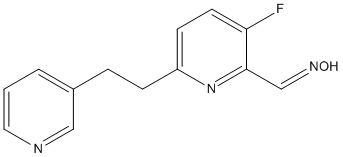6-Alkyl-3-Fluoro-2-pyridinaldoxime-12d
General
Type : Pyridine, Oxime, Pyridine-aldoxime
Chemical_Nomenclature : N-[[3-fluoro-6-(2-pyridin-3-ylethyl)pyridin-2-yl]methylidene]hydroxylamine
Canonical SMILES : C1=CC(=CN=C1)CCC2=NC(=C(C=C2)F)C=NO
InChI : InChI=1S\/C13H12FN3O\/c14-12-6-5-11(17-13(12)9-16-18)4-3-10-2-1-7-15-8-10\/h1-2,5-9,18H,3-4H2
InChIKey : CKUUWPBCPYJLIA-UHFFFAOYSA-N
Other name(s) :
MW : 245.25
Formula : C13H12FN3O
CAS_number :
CID PubChem :
InChIKey UniChem :
Iuphar :
Wikipedia :

Target
Structure : No structure
Families : No family
References
No reference